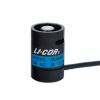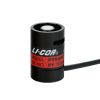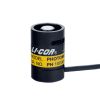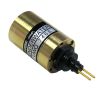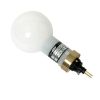LI-COR LI-1500 Light Sensor Logger
Features
- Weather resistant console constructed to withstand impact
- Sample and log measurements up to 500 Hz
- Optional GPS for recording location of measurements
- Free ground shipping
- Expedited repair and warranty service
- Lifetime technical support
- More
Overview
The LI-COR LI-1500 is a light sensor logger with a menu-driven interface, making it easy to use. Attach LI‑COR light sensor(s) to the three BNC connectors. Log manually or use menus to set up one-time, daily, or continual measurement routines. Sampling rates and logging intervals are user-selectable.
Durable
The LI‑1500 features rugged housing and a compact design suitable for handheld outdoor use. A rubber seal between the two halves also serves as a shock cushion. The LI‑1500 is powered by four AA batteries providing over 80 hours of operation with typical usage or 40 hours with the GPS option turned on. Power can also be supplied from an AC wall outlet with the provided USB adapter.
Data Presentation
Graph large data sets using LI‑COR’s FV7x00 software, available for free download. Also, view real-time light measurements, GPS data, and other variables on the eight-line display screen.
Data Storage
The LI‑1500 stores a large amount of logged data on an internal SD card (1 GB of flash memory). Store up to 100 sensor configurations and sensor-specific calibration coefficient information for later use. Download the sensor’s calibration certificate from the LI‑COR website. Enter the calibration coefficient (multiplier) and the date of the last calibration just once. When attached to a computer, the LI‑1500 acts as a mass-storage device with a simple drag-and-drop file system. Logged data can be transferred to a computer with the included USB cable. Data is formatted for easy import. Configurations and sensor calibration data can also be transferred to a computer and then shared with other LI‑1500 units
Connections
Use the LI‑1500 with LI‑COR sensors to log photosynthetically active radiation (PAR), global solar radiation, and light (the visible spectrum). PAR can also be measured along transects under a plant canopy with the LI-1500. Connect up to three sensors at the same time. For instance, use two PAR sensors to measure incident radiation above and below a plant canopy. Features a built-in math function for measuring vertical attenuation using two underwater PAR sensors. The three input ports also allow for the measurement of incident PAR above water while measuring simultaneous upwelling and downwelling PAR below water.
Global Positioning System (GPS)
The LI‑1500 features an optional global positioning system (GPS) for recording the location of measurements. The GPS facilitates repeated visits to the same location for tracking light levels over time. GPS data can be logged independently or with light data.
- (1) LI-1500 light sensor logger
- (4) AA batteries
- (1) USB cable
- (1) AC to DC power supply adapter
- (1) Carabiner clip
- (1) Carrying case
- (1) Instruction manual
In The News
Supplying Seattle’s Drinking Water: Using Data Buoys to Monitor the Cedar River Municipal Watershed
Providing clean, safe, and reliable drinking water for the 1.6 million people in the greater Seattle area is a top priority for Seattle Public Utilities (SPU). With limited water supplies, SPU dedicates considerable resources to maintain its watersheds and mountain reservoirs. About 70 percent of Seattle Water comes from the Cedar River Municipal Watershed , and the other 30 percent comes from the South Fork Tolt River Watershed . [caption id="attachment_39574" align="alignnone" width="940"] Data buoy in Chester Morse Lake . (Credit: Kevin Johnson / Seattle Public Utilities) [/caption] Jamie Thompson, a fisheries biologist at SPU, monitors aquatic ecosystems centered on fish listed under the U.S. Endangered Species Act (ESA).
Read MoreData-Driven Advocacy on the Lower Deschutes River
Like many freshwater environments, the Deschutes River in Oregon is under pressure from development, pollution, and climate change. Many rivers, streams and lakes in the Deschutes Basin do not meet Oregon water quality standards –where state water quality monitoring assesses levels of bacteria, pH, dissolved oxygen, temperature, and fine sediment. Hannah Camel is the Water Quality Coordinator for the Deschutes River Alliance (DRA), a non-profit organization that focuses on the health of the lower 100 miles of the Deschutes River–the area most affected by human intervention. As a data-driven organization, the DRA has benefited from the installation of two NexSens X2 data loggers.
Read MoreExpanding the Port Everglades: Real-Time Monitoring of Water Quality Conditions from Planned Dredging Operation
The Port Everglades in Broward County, Florida, serves large trade vessels and cruiseliners and incoming and outgoing recreational boaters. However, as cargo ships become larger, the port must expand. A dredging project led by the US Army Corps of Engineers will substantially deepen and widen the port's navigation channel to accommodate larger Panamax cargo ships and modern cruise liners. As a result of this project, a large amount of sediment will be displaced into the water column. This suspended sediment may settle outside of the project area, burying benthic organisms like corals, and possibly carrying harmful particulates to other regions. [caption id="attachment_39497" align="aligncenter" width="2560"] A CB-950 and CB-25 deployed on site at Port Everglades.
Read More





























